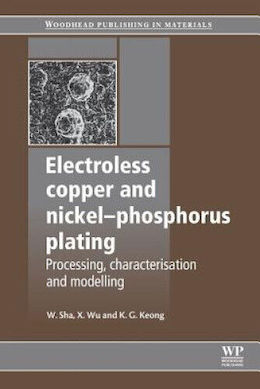
Curated with aloha by
Ted Mooney, P.E. RET

The authoritative public forum
for Metal Finishing 1989-2025

-----
Resist for copper: dry film vs. pad print ink
2000
Can anyone explain to me what a photoresist (dry film) is and it's applications. We currently use a Hysol resist (paint like) and Etch the unwanted copper with an 8% Ammonium Persulphate.. followed by a Sodium Hydroxide solution to remove the resist. The pad printed design is not giving us the crisp edges we are looking for and we are noticing about a loss of 20-30 microinches of the electroless copper. We only start off with between 60-100.
Our base material is ABS. Is photoresist something we can use and accurately locate on the part or is there something we can improve in the process to get better coverage of our current process.
Thank you in advance.
Tom Greifenkamp- Cincinnati, Ohio
by Sha, Wu, & Keong

on eBay or
AbeBooks
or Amazon
(affil links)
I'm not familiar with pad print resists, but will say that you can get excellent image definition with dry film photoresists. There are a number of vendors with a lot of experience. Proper exposure and development are critical. Stripping can be done with either a NaOH solution or a proprietary solution; that's something you can talk about with the dry film vendor.
You might consider using sodium persulphate rather than ammonium persulphate as the etch; it will work about the same without the smut or waste treatment problems.

James Totter, CEF
- Tallahassee, Florida
Tom,
Sounds like you are using an alkaline strippable screen resist. Hysol has made these for years and makes good ones. I would suggest contacting a technical rep from that company who can advise you on screen mesh, squeegee angle, and a host of other techniques to improve line resolution. The so called "Dry Films" are an alkaline developable, photo-sensitive layer of between .5 to as much as 3.0 mils sandwiched between a layer of 1.0 mil Mylar and !.0 mil polyethylene. The photoresist comes in rolls and require a laminating machine to apply. The machine strips the polyethylene and applies the resist layer directly to the part with heat and pressure, and coats top and bottom at the same time. The part is then exposed through a positive or negative depending on the process, the Mylar sheet removed, and the part developed in sodium or potassium carbonate at approximately 1.0%. Proprietary potassium carbonate developers work best for fine line work. Dry Film manufacturers include DuPont's Riston Division, the former Morton/Thiokol(now either Shipley or Rohm & Haas), and Eternal Films represented by GDI(Grimes Distribution Inc.)in Mission Viejo,California. Good luck
James TaylorDURATECH INDUSTRIES, INC. - Orange, California
2000
Dear Tom,
Looks like you are etching out unwanted copper using Ammonium persulphate and shield the required copper with Hysol Ink( Paint).
Dry Film Resist is used for the production of Printed circuit boards. It is acid etch resist and alkali soluble. It can be laminated over a surface and then the required pattern can be exposed over it using Film. After etching it can be stripped.
Let me know if you need more details,
Regards,
Mukesh Narain- New Delhi, India
2001
How can I print or expose design on Glass, Which kind of paint or chemical is useable for that as if I use silicon what will its process and than after etching how can I clean Silicon ? Please answer.
Muhammad YahyaHarmain Arts - Faisalabad, Pakistan
2006
Q, A, or Comment on THIS thread -or- Start a NEW Thread
